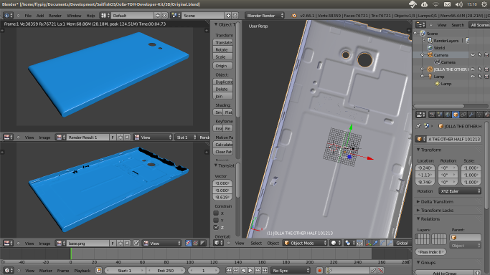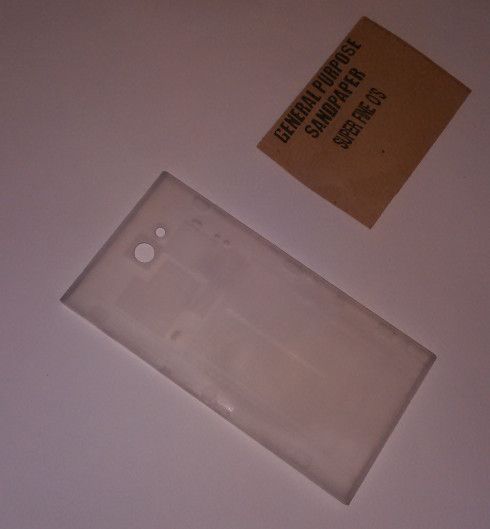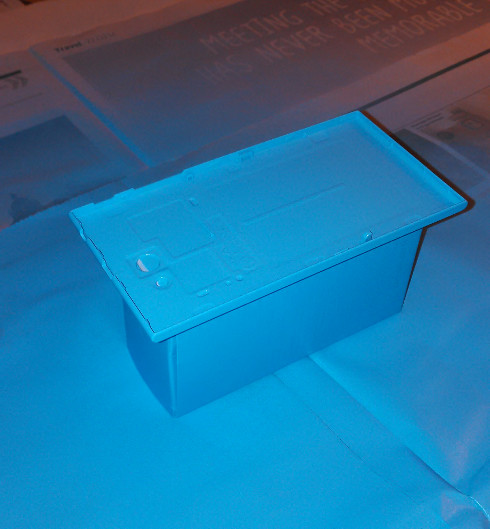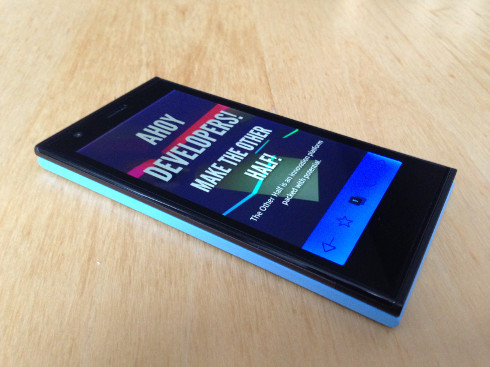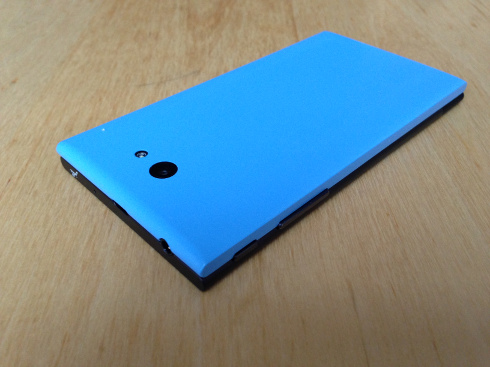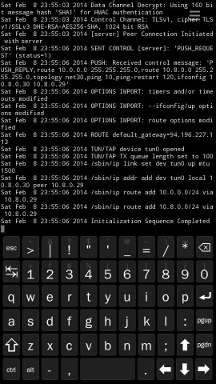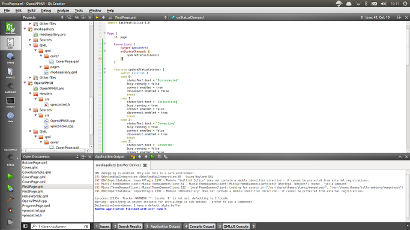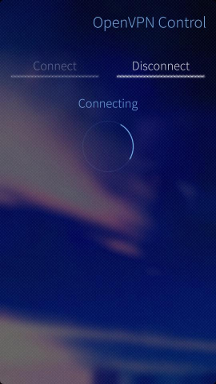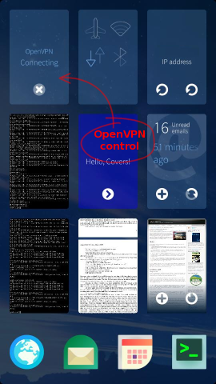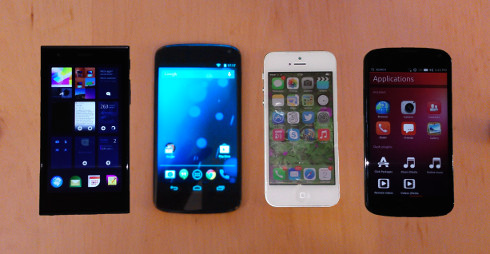List items
Items from the current list are shown below.
Blog
All items from February 2014
No, this is to do with my Jolla phone. Back in the day, before smartphones were ubiquitous, many phone manufacturers tried to lure in the punters by offering interchangeable fascias or backplates. Not very subtle, or high-tech, but presumably effective.
Well, Jolla have decided to return to this, while taking the opportunity to update it for the 21st Century. Each Jolla smartphone appears to be built in two halves, split parallel to the screen and with the back half ("The Other Half") replaceable to provide not just different styles, but also additional functionality. The extra functionality is provided by cleverly using NFC-detection of different covers, along with the ability for covers to draw power from and communicate with the main phone via a selection of pins on the back.
At the moment there are only four official Other Halves that I'm aware of: Snow White (the one that comes as standard), Keira Black, Aloe and Poppy Red (the preorder-only cover). They use the NFC capability to change the styling of the phone theme as the cover is changed, but in the future there's a hope that new covers might provide things light wireless charging, solar charging, pull-out keyboard, etc.
For me, the interesting thing about the phone has always been the Sailfish OS that powers it. As anyone who's ever set eyes on me will attest, I've never been particularly fashion conscious, so the prospect of switching my phone cover to match my outfit has never offered much appeal. However, since the good sailors at Jolla have released a development kit for The Other Half, and since it seemed like an ideal challenge to test out the true potential of future manufacturing - by which I mean 3D printing - this was not an opportunity I could not miss.
Rather brilliantly, the development kit includes a 3D model which loads directly into Blender.
From there it's possible to export it in a suitable format for upload directly to the Shapeways site. The model is quite intricate, since it has various hooks and tabs to ensure it'll fit cleanly on to the back of the phone. Sadly this means that most of the usual materials offered by Shapeways are unavailable without making more edits to the model (sadly, it will take a bit more work before it can be printed in sterling silver or ceramic!). My attempt to print in polished Strong & Flexible failed, and eventually I had to go with Frosted Ultra Detail. Not a problem from a design perspective, but a bit more expensive.
The result was immaculate. All of the detail retained, a perfect fit on the phone and a curious transparent effect that allows the battery, sim and SD card to be seen through the plastic.
Although a perfect print, it wasn't a good look. Being able to see the innards of the phone is interesting in an industrial kind of way, but the contouring on the inside results in a fussy appearance.
The good news is that all of the undulations causing this really are on the inside. The outer face is slightly curved but otherwise smooth. The printing process results in a very slight wood-grain effect, which I wasn't anticipating, but in hindsight makes sense. The solution to all of this was therefore to sand the outside down and then add some colour.
The colour I chose was a pastel blue, or to give its full title according to the aerosol it came in, Tranquil Blue. Irrespective of the paint company's choice of name, the result was very pleasing, as you can see from the photos below. The 3D-printed surface isn't quite as nicely textured as the original Other Half cover that came with the phone, but I believe most people would be hard-pressed to identify it as a 3D-printed cover. It looks as good as you might expect from mass-produced commercial plasticware.
With the design coming straight from the developer kit, I can't claim to have made any real input to the process. And that's an amazing thing. Anyone can now generate their own 3D printed Other Half direct from Shapeways with just a few clicks (and some liberal unburdening of cash, of course!). A brand-new or updated design can be uploaded and tested out just as easily.
It's genuinely exciting to see how 3D printing can produce both practical and unique results. The next step will be to add in the NFC chip (it turns out they're very cheap and easy to source), so that the phone can identify when the cover is attached.
There's no shortage of places to get Apps from for a Jolla phone: the Jolla Store, the Yandex Store and the OpenRepos Warehouse being just a few. But even with this smörgåsbord of stores there are still obvious gaps. For example, I wanted to connect my phone through my home VPN, so that I can access things like SMB shares and ssh into my machines.
The iPhone has an OpenVPN client, but the frustrating file management on the iPhone meant I never got it up and running. Unsurprisingly Android has good OpenVPN support which combines well with the broad range of other good network tools for the platform.
In contrast the various SailfishOS stores are sadly bereft of OpenVPN solutions. However, a quick search using pkcon showed the command line openvpn client available in the Jolla repositories. I was astonished when, after a few commands to transfer the relevant client certificates and install the tool, it was able to connect to my VPN first time.
This is what I'm loving about SailfishOS. It speaks the same language as my other machines and runs the same software. Getting it to talk to my VPN server was really easy, even though you won't find this advertised in the headline features list.
Still, having a command line tool isn't the same as having a nicely integrated GUI App, so this seemed like a great opportunity to try out Jolla's Qt development tools. I've not done any Qt development in the past so started by working through the examples on the Sailfish site.
Qt seems to be a nice toolkit and it's set up well for the phone, but Qt Quick and QML in particular require a shift in approach compared to what I'm used to. Qt Quick obfuscates the boundary between the QML and C++ code. It's effective, but I find it a bit confusing.
Still, after a weekend of learning and coding, I've been able to knock together a simple but effective front-end for controlling OpenVPN connections from my phone.
As well as providing a simple fullscreen interface, you can also control the connection directly from the home screen using the clever SailfishOS multi-tasking cover gestures: pull the application thumbnail left or right to connect to or disconnect from the server.
What I think this demonstrates is how quick and easy it is to get a useful application up and running. The strength is the combination of the existing powerful Linux command line tools, and the ability to develop well-integrated SailfishOS user interfaces using Qt. I'm really pleased with the result given the relatively small amount of effort required.
If I get time, there's plenty more to be done. Currently the configuration runs directly from the openvpn script, but allowing this to be configured from the front-end would be an obvious and simple improvement. After this, mounting SMB shares will be next.
My smartphone experience has been coloured by the earlier devices that defined my computing development. The strength of a device has always been measured - for me - by the potential to program directly on the device. What's the point of carrying a computer around if you can't use it to compute?! From Psions to Nokia Communicators through to the ill-fated Meamo devices, this has always been by far their most exciting trait. When Maemo/Meego was killed off, the only real alternatives were iOS and Android. I tried both. Android is the spiritual successor to Windows. Its strength is defined by the software that runs on top of it, and it's open enough to interest developers. It's not so bad that people want to avoid it but nonetheless doesn't excel in any particular way. The iPhone on the other hand is an astonishing device. It achieves simplicity through a mixture of control and illusion. In its own way it's perfect, making an excellent communication device. A computing device: less so. As an aside, both devices are also Trojan horses. Google just wants you logged in to your Google account so it can collect data. Apple wants to seduce you in to its ecosystem, if necessary by making it harder to use anything else. Both are fine as long as the value proposition is worth it. In February 2013 I finally decided to retire my N900. The provocation for this was actually the release of the Ubuntu Touch developer preview. I purchased a Nexus 4, which is a beautiful piece of hardware, and flashed it with Ubuntu. Sadly, the operating system wasn't ready yet. I've kept the OS on the phone up-to-date (the device is now dual-boot) and in fact it's still not ready yet. If it fulfils its goal of becoming a dual mobile/desktop OS, it could have real potential. But (in the immortal words of Juba) "not yet". So, in May 2013 I moved to an iPhone. The main motivation for this was to try to establish what data Apple collects during its use, especially given the way Siri works. I've continued using it for this purpose until now, maintaining it exclusively as my main phone in order to ensure valid results. After ten months of usage I think I've given it a fair tryout, but it's definitely not for me. It implements non-standard methods where existing standards would have worked just as well. Options are scattered around the interfaces or programs through a mixture of soft-buttons, hardware-buttons and gestures. I find this constantly frustrating, since most of the time the functionality I'm after doesn't actually exist. Yes, mystery meat navigation has escaped the nineties: it's alive and well on the iPhone. The hardware - while well made - is fussy with its mixture of materials and over-elaborate bevelling. However, ultimately what rules it out is the lack of support for programming the device on the device. There are some simple programming tools, but nothing that really grants proper control. Finally I've ended up with a Jolla phone running Sailfish OS. There's no doubt that this is the true successor to Maemo. If you have fond memories of the Internet Tablet/N900/N9/N950 line of devices, then I'd recommend a Jolla. If you like Linux and want a phone that really is Linux, rather than a Java VM that happens to be running on the Linux kernel, then I'd recommend a Jolla. Clearly, I'm still suffering from the first-flush of enthusiasm, but it definitely feels good to be finally in possession of a phone that I feel like I can control, rather than one that controls me. For the record, the photo shows (from right to left) Ubuntu Touch running on a Nexus 4, an iPhone 5 running iOS 7.0.4, Android 4.4.2 KitKat on a Nexus 4 and a Jolla device running Sailfish OS 1.0.3.8 (Naamankajärvi). There are actually only three devices here: both Nexuses are the same. The overall photo and Android device was taken using the Jolla; the Jolla and Ubuntu phones were shot with the iPhone; the iPhone photo was taken with the Android. I had an interesting experience getting all of the photos off the phones and onto my computer for photoshopping together. Getting the photos off the Jolla and Android devices was easy enough using Bluetooth transfer. The iPhone inexplicably doesn't support Bluetooth file transfer (except with the uselessly myopic AirDrop), and getting anything off the device is generally painful. Eventually I used a third-party application to share the photos over Wi-Fi. However, it was Ubuntu Touch that gave the most trouble. The Nexus 4 doesn't support memory cards, Ubuntu Touch doesn't yet support Bluetooth and the only option offered was to share via Facebook. I gave up on this. No doubt Ubuntu Touch will improve and ultimately outdo iOS on this, but... not yet.
